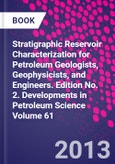Reservoir characterization as a discipline grew out of the recognition that more oil and gas could be extracted from reservoirs if the geology of the reservoir was understood. Prior to that awakening, reservoir development and production were the realm of the petroleum engineer. In fact, geologists of that time would have felt slighted if asked by corporate management to move from an exciting exploration assignment to a more mundane assignment working with an engineer to improve a reservoir's performance.
Slowly, reservoir characterization came into its own as a quantitative, multidisciplinary endeavor requiring a vast array of skills and knowledge sets. Perhaps the biggest attractor to becoming a reservoir geologist was the advent of fast computing, followed by visualization programs and theaters, all of which allow young geoscientists to practice their computing skills in a highly technical work environment. Also, the discipline grew in parallel with the evolution of data integration and the advent of asset teams in the petroleum industry. Finally, reservoir characterization flourished with the quantum improvements that have occurred in geophysical acquisition and processing techniques and that allow geophysicists to image internal reservoir complexities.
Please Note: This is an On Demand product, delivery may take up to 11 working days after payment has been received.
Table of Contents
1. Basic principles and applications of reservoir characterization2. Basic sedimentary rock properties
3. Geologic time and basic stratigraphy
4. Tools and techniques for reservoir
5. Sequence stratigraphy for reservoir characterization
6. Geologic controls on reservoir quality
7. Fluvial deposits and reservoirs
8. Eolian (windblown) deposits and reservoirs
9. Shallow marine (deltaic and non-deltaic) deposits and reservoirs
10. Deepwater deposits and reservoirs
11. Unconventional reservoirs
12. Basic structural attributes of reservoirs
13. Geomodeling








